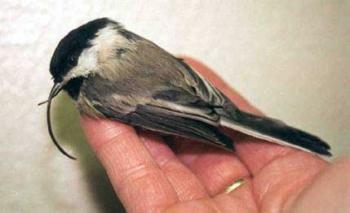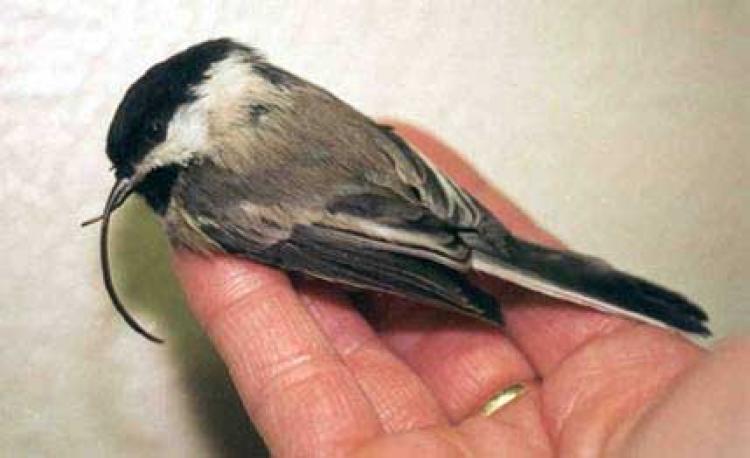In Alaska, a growing phenomenon involving the deformation of bird beaks among many varieties of bird species signals a potential serious environmental problem.
The beak deformations are at their highest rate they have ever been in recorded history, and affect bird species in Alaska and other parts of the Northwest, like British Columbia and Washington state.
The black-capped chickadees as well as Northwestern crows and other bird species are being affected by the phenomenon whose technical term is “avian keratin disorder.” The disorder manifests itself as an overgrowth of the keratin layer of the beak, which appears as an elongation of the beak.
Sometimes the condition is accompanied by a disfigurement of the skin, legs, feet, claws, and even feathers. This problem is rather serious because it has the compounded effect of affecting the bird’s ability to feed and clean itself and its young.
“The prevalence of these strange deformities is more than ten times what is normally expected in a wild bird population. We have seen effects not only on the birds’ survival rates, but also on their ability to reproduce and raise young. We are particularly concerned because we have not yet been able to determine the cause, despite testing for the most likely culprits,” said Colleen Handel, a biologist with the U.S. Geological Survey in a statement earlier this month.
The beak deformations in the black-capped chickadees were first seen in the early ‘90s. The numbers increase every year with 6.5 percent of adult black-capped chickadees being affected and 2,100 being visually accounted for. The numbers are increasing for other species as well, with an estimated 17 percent of adult Northwestern crows being affected.
The cause of avian keratin disorder is still a mystery to biologists, however. These scientists speculate that environmental contaminants, nutritional deficiencies, bacterial, viral, fungal, or parasitic infections could be the cause.
As of this moment, scientists’ best guess include environmental contaminants as the main suspect. In the past, such deformations were the result of environmental contamination like the pollutants organochlorines in the Great Lakes and selenium runoff in California. Scientists in these areas eventually realized the problem and corrections were made.
“We’re seeing ecologically unique species affected across a wide range of habitats. The scope of this problem raises concern about environmental factors in the region,” said Caroline Van Hemert, another biologist with the U.S. Geological Survey Wildlife in the statement.
The deformations exist across many different types of birds in different locations in the Northwest. These conclusions lead these biologists to think that it may be an unseen environmental pollutant.
Biologists studying this problem have recently published their findings in this month’s edition of The Auk, which is a Journal of Ornithology published four times a year.
“Epizootic of beak deformities among wild birds in Alaska: An emerging disease in North America?” and “Beak deformities in Northwestern Crows: Evidence of a multispecies epizootic,” are available in this month’s printed issue of The Auk.
The U.S. Geological Survey biologists continue to study the problem with no conclusions yet found. Current research is focused on understanding the disease and the possible sources of the deformation. The U.S. Geological Survey website (http://alaska.usgs.gov/) is asking residents in the Northwest to contact them if they see a bird with a disfigured beak.
The beak deformations are at their highest rate they have ever been in recorded history, and affect bird species in Alaska and other parts of the Northwest, like British Columbia and Washington state.
The black-capped chickadees as well as Northwestern crows and other bird species are being affected by the phenomenon whose technical term is “avian keratin disorder.” The disorder manifests itself as an overgrowth of the keratin layer of the beak, which appears as an elongation of the beak.
Sometimes the condition is accompanied by a disfigurement of the skin, legs, feet, claws, and even feathers. This problem is rather serious because it has the compounded effect of affecting the bird’s ability to feed and clean itself and its young.
“The prevalence of these strange deformities is more than ten times what is normally expected in a wild bird population. We have seen effects not only on the birds’ survival rates, but also on their ability to reproduce and raise young. We are particularly concerned because we have not yet been able to determine the cause, despite testing for the most likely culprits,” said Colleen Handel, a biologist with the U.S. Geological Survey in a statement earlier this month.
The beak deformations in the black-capped chickadees were first seen in the early ‘90s. The numbers increase every year with 6.5 percent of adult black-capped chickadees being affected and 2,100 being visually accounted for. The numbers are increasing for other species as well, with an estimated 17 percent of adult Northwestern crows being affected.
The cause of avian keratin disorder is still a mystery to biologists, however. These scientists speculate that environmental contaminants, nutritional deficiencies, bacterial, viral, fungal, or parasitic infections could be the cause.
As of this moment, scientists’ best guess include environmental contaminants as the main suspect. In the past, such deformations were the result of environmental contamination like the pollutants organochlorines in the Great Lakes and selenium runoff in California. Scientists in these areas eventually realized the problem and corrections were made.
“We’re seeing ecologically unique species affected across a wide range of habitats. The scope of this problem raises concern about environmental factors in the region,” said Caroline Van Hemert, another biologist with the U.S. Geological Survey Wildlife in the statement.
The deformations exist across many different types of birds in different locations in the Northwest. These conclusions lead these biologists to think that it may be an unseen environmental pollutant.
Biologists studying this problem have recently published their findings in this month’s edition of The Auk, which is a Journal of Ornithology published four times a year.
“Epizootic of beak deformities among wild birds in Alaska: An emerging disease in North America?” and “Beak deformities in Northwestern Crows: Evidence of a multispecies epizootic,” are available in this month’s printed issue of The Auk.
The U.S. Geological Survey biologists continue to study the problem with no conclusions yet found. Current research is focused on understanding the disease and the possible sources of the deformation. The U.S. Geological Survey website (http://alaska.usgs.gov/) is asking residents in the Northwest to contact them if they see a bird with a disfigured beak.






